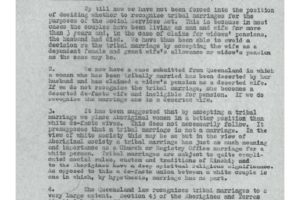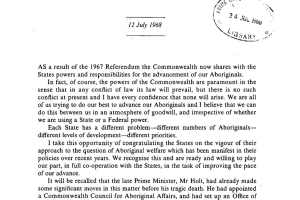
Artefacts about Assimilation & Exemption
In an excerpt in a book about the Aboriginal-Australian Fellowship, an Aboriginal veteran recalled the difficult fight for Aboriginal rights in New South Wales.
The Social Services Act of 1947 was amended in 1959 and some of the discriminatory passages were removed. However, it continued to exclude some Aboriginal and Torres Strait Islander people from social services.
Believing Aboriginal people couldn’t manage their own money, the New South Wales Government monitored and reported on how Aboriginal people spent federal government payments once they started receiving them.
In a series of letters, senior DSS officials discussed government payments at New Mapoon in Queensland. Their discussion revealed the deeper issue of the way the Queensland Government exerted control over Aboriginal and Torres Strait Islander people’s lives.
Even though social security was a federal responsibility, the Western Australian Department of Native Welfare issued a booklet for Aboriginal people instructing them to access payments through state-based officers.
In the 1960s, DSS was questioned about their policy of not supporting multiple wives within Aboriginal marriages. They wouldn’t review their policy for years to come.
An article published by the Aborigines Welfare Board explained Widow Pension and Old-age Pension in simpler language than earlier government ads.
Prime Minister John Gorton reaffirmed his government’s commitment to assimilation policy in his address at a conference about Aboriginal and Torres Strait Islander affairs.







